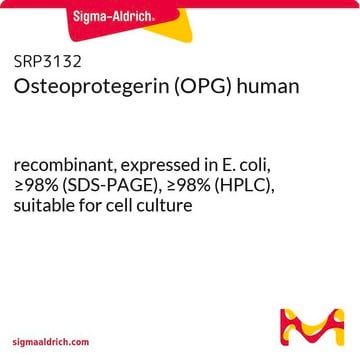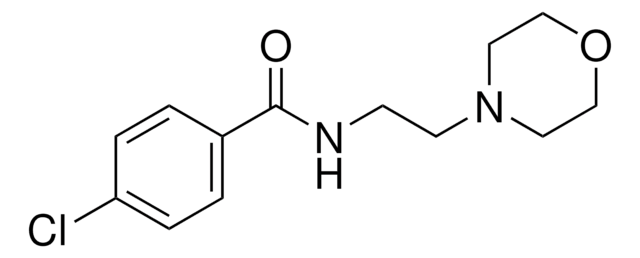推薦產品
生物源
mouse
品質等級
重組細胞
expressed in NSO cells
化驗
>95% (SDS-PAGE)
形狀
lyophilized powder
效力
25-50 ng/mL ED50
分子量
100 kDa by SDS-PAGE (reducing)
calculated mol wt 70.9 kDa
包裝
pkg of 100 μg
雜質
endotoxin, tested
UniProt登錄號
儲存溫度
−20°C
SMILES 字串
CCCCCCCCCCC#CCCCCCC(O)=O
InChI
1S/C18H32O2/c1-2-3-4-5-6-7-8-9-10-11-12-13-14-15-16-17-18(19)20/h2-10,13-17H2,1H3,(H,19,20)
InChI 密鑰
XXUPLYBCNPLTIW-UHFFFAOYSA-N
基因資訊
mouse ... Tnfrsf11b(18383)
相關類別
一般說明
Osteoprotegerin (OPG) is a member of the TNFR (tumor necrosis factor receptor) superfamily that can act as a decoy receptor for RANKL (receptor activator of nuclear factor κ-B ligand) and TRAIL (tumor necrosis factor-related apoptosis-inducing ligand).[1][2] The primary structure of OPG protein consists of seven distinct domains, four of which corresponds to the extracellular cysteine-rich domains of TNFR proteins and constitutes the soluble OPG. OPG is expressed in a wide variety of tissues including adult heart, lung, kidney and liver. It is secreted both as a monomeric and a dimeric protein.[3]
生化/生理作用
Binding of soluble osteoprotegerin (OPG) to sRANKL (soluble receptor activator of nuclear factor κ-B ligand) inhibits osteoclastogenesis by interrupting the signaling between stromal cells and osteoclastic progenitor cells, thereby leading to excess accumulation of bone and cartilage.[1] Changes in the level of serum OPG are associated with atherosclerosis and cardiovascular disorders.[2] It might also be associated with malignancy and plays a regulatory role in multiple myeloma, prostate, breast, bladder and gastric carcinoma.[4] OPG plays a vital role in bone metabolism and is involved in inhibition of ovariectomy-associated bone loss in rats.[3][4]
OPG is a soluble secreted member of the tumor necrosis factor receptor superfamily that lacks any apparent cell-association motifs. It regulates the formation of osteoclasts and is involved in the regulation of bone resorption and remodeling. Human and mouse OPG share approximately 84% and 94% amino acid sequence identity, respectively, with rat OPG.
Soluble secreted member of the tumor necrosis factor receptor superfamily that lacks any apparent cell-association motifs; regulates the formation of osteoclasts and is involved in the regulation of bone resorption and remodeling.
外觀
Lyophilized from a 0.2 μm filtered solution in phosphate buffered saline.
分析報告
The biological activity is measured by its ability to neutralize apoptosis of mouse L-929 cells treated with 50 ng/ml recombinant human TRAIL.
儲存類別代碼
11 - Combustible Solids
水污染物質分類(WGK)
WGK 3
閃點(°F)
Not applicable
閃點(°C)
Not applicable
Osteoprotegerin secreted by inflammatory and invasive breast cancer cells induces aneuploidy, cell proliferation and angiogenesis.
Goswami S and Sharma-Walia N
BMC Cancer, 15:935 (2015)
Functions of RANKL/RANK/OPG in bone modeling and remodeling.
Boyce BF and Xing L.
Archives of Biochemistry and Biophysics, 473(2), 139-146 (2008)
Osteoprotegerin: a novel secreted protein involved in the regulation of bone density.
Simonet WS
Cell, 89(2), 309-319 (1997)
Polymorphisms in three genes are associated with hemorrhagic stroke.
Liu W
Brain and Behavior, 5(11), e00395-e00395 (2015)
Active Filters
我們的科學家團隊在所有研究領域都有豐富的經驗,包括生命科學、材料科學、化學合成、色譜、分析等.
聯絡技術服務






![双[2-(2-氯化乙氧基)乙基]醚 ≥99.0% (T)](/deepweb/assets/sigmaaldrich/product/structures/333/320/46ff3398-7a62-42b5-b9bc-0a3d0cb0429c/640/46ff3398-7a62-42b5-b9bc-0a3d0cb0429c.png)
![氯(4-氰基苯基)[(R)-1-[(S)-2-(二环己基膦基)二茂铁基]乙基二环已基膦]镍(II)](/deepweb/assets/sigmaaldrich/product/structures/308/161/648149e1-191f-48a0-af54-81c827b98fc9/640/648149e1-191f-48a0-af54-81c827b98fc9.png)
